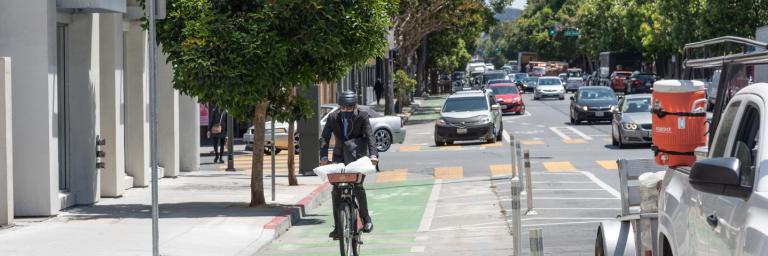Thanks to all of your efforts during this pandemic, San Francisco is ready to begin safely reopening offices. However, as with all other aspects of public life during the COVID-19 pandemic, commuting has changed in San Francisco.
San Francisco has already reached pre-COVID levels of traffic congestion. To allow for distancing per San Francisco Department of Health guidelines, Muni vehicles are beyond capacity and will pass up stops when they are full to allow physical distancing and prevent the spread of COVID-19. As offices reopen, this means that we all need to adapt our normal commutes.
To prevent the crushing congestion that will increase all our travel times, hinder economic recovery and frustrate everyone, businesses in San Francisco must all work to make the following changes to support employees' commutes:
-
Stagger working hours and adopt alternative work schedules to shift your travel to off-peak times for employees who must return to work
-
Allow employees to continue working remotely as much as possible.
-
For employees who must return to the office from within San Francisco, communicate that they should walk, bike or use another sustainable travel alternative to Muni or driving alone. See resources for employees below.
-
Encourage employees who must return to the office from outside of San Francisco to use BART, ferries and other regional transit whenever possible.
To help all of us make these changes, please review the additional information and resources below. For more information on the SFMTA’s COVID-19 Response, please visit SFMTA.com/COVID.
Sustainable Travel Alternatives
Help save space on Muni for front-line workers and those who are transit-dependent if you are able by walking, bicycling, or using another sustainable travel alternative rather than using Muni or driving alone for your commute. For those employees who will be traveling to work differently than they did in the past, resources to plan a commute are below.
Bicycling
San Francisco has over 456 miles of Bicycle Routes, making it easy for residents to begin commuting by bicycle – and you don’t even need to own a bike to take advantage of them. Explore the full Bike Network including Slow Streets, bike lanes, and physically-separated bikeways to plan a low-stress route to work. The San Francisco Bicycle Coalition provides resources to help new bike commuters and also offers free webinars on urban cycling. There are also options to rent a bike or scooter, see “Need a Bike or Scooter?” below.
Walking
San Francisco's a walking city and during this pandemic, we need everyone who can to walk even more. Walking to work frees up seats on Muni and helps with the current physical distancing requirements needed to reduce the risk of COVID-19 transmission as our city starts to emerge from the pandemic. Now, San Franciscans can plan their commute on foot by using Slow Streets for a more comfortable commute with limited vehicle traffic.
Slow Streets
The SFMTA’s new Slow Streets program allows people traveling by foot or bicycle to do so on certain residential streets that are designed to limit thru traffic. Throughout the city, nearly thirty corridors have been implemented as a Slow Street. On these Slow Streets, signage and barricades have been placed to minimize through vehicle traffic and prioritize walking and biking.
 Map of Slow Streets, bike network and other COVID-19 Street Changes. When using Google Maps, Slow Streets can be identified by blue and white dashed lines.
Map of Slow Streets, bike network and other COVID-19 Street Changes. When using Google Maps, Slow Streets can be identified by blue and white dashed lines.
Need a Bike or Scooter?
If you don’t own a bicycle or scooter, San Francisco has multiple options for shared bicycles and scooters. All have easy signup processes and follow recommended public health practices to ensure rider safety and well-being. Find links to their registration pages below to start riding today.
-
BayWheels Bicycle Share. Bike Share for All provides a discounted membership option for low-income residents.
-
Scooter Shares:
-
Lime. Lime Access provides discounted option for low-income residents.
-
Scoot. Its Community Plan provides discounted option for low-income residents.
-
Spin. Spin Access provides discounted option for low-income residents.
-
Muni
Public Health Updates
SFMTA continues to follow the advice of the San Francisco Department of Public Health about the capacity of our vehicles. As a result, many of our vehicles are regularly reaching capacity, and operators may skip stops or refuse service to protect the health of all on board. Customers are encouraged to allow for more travel time, be patient, and wait for the next bus if it is full.
No direct correlation has been found between use of public transit and transmission of COVID-19. Please continue following the best practices below to keep our operators and your fellow passengers safe.
How Tos for riding Muni during COVID-19
-
Face coverings that cover your nose and mouth are required while waiting for and riding Muni.
-
Maintain distance from other passengers whenever possible--on the vehicle and at stops--to minimize the risk of transmission
-
Travel at less busy times if you are able.
Planning your trip on Muni
Reset to default view
Export image
Download displayed data in excel format
Download complete/accessible data for this metric
Muni Service Updates
Muni service is temporarily reduced in order to focus limited resources on our most-used routes and serve critical connections like medical facilities. When bringing back Muni routes, we are prioritizing capacity for physical distancing, high-ridership routes, and communities most dependent on Muni service.
